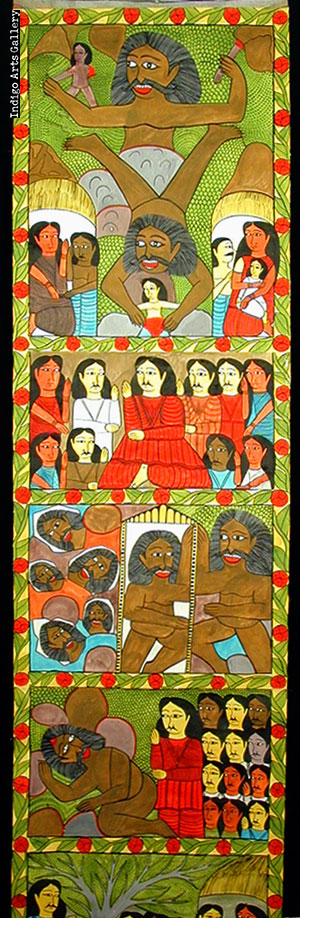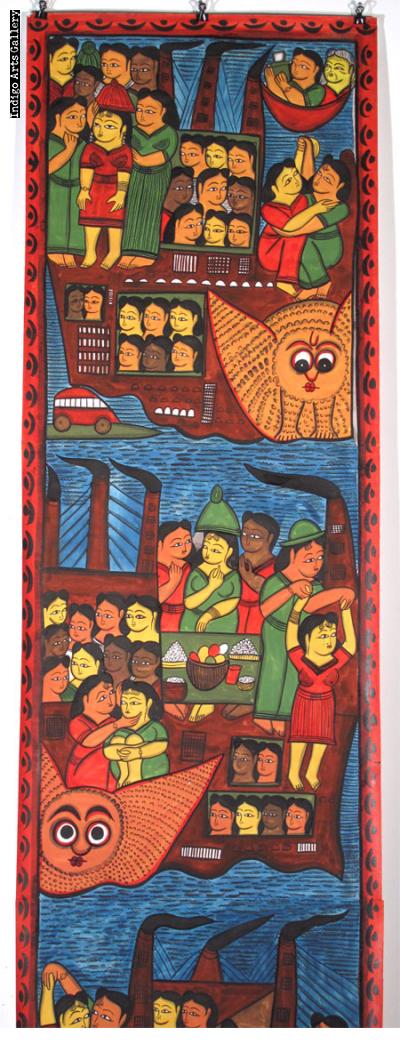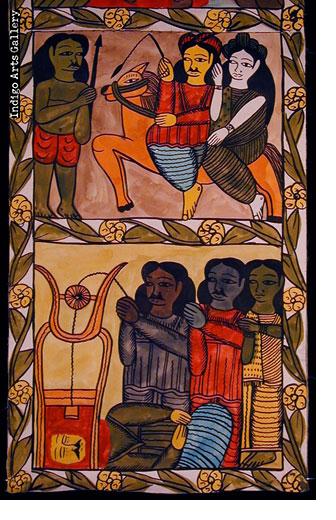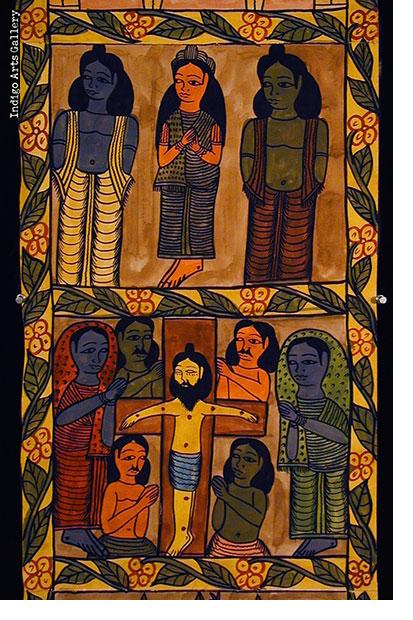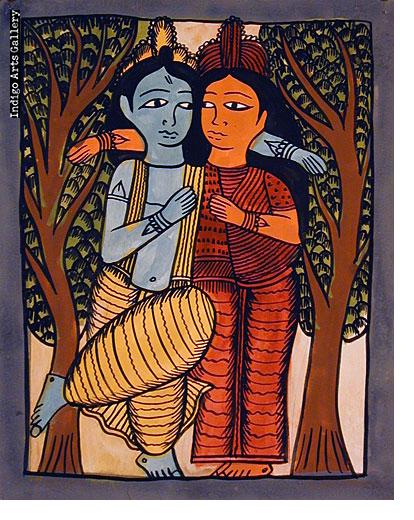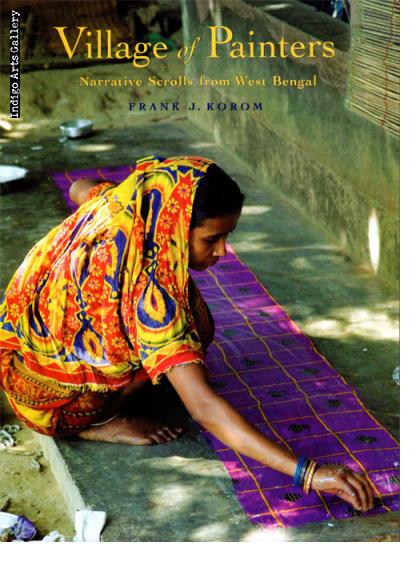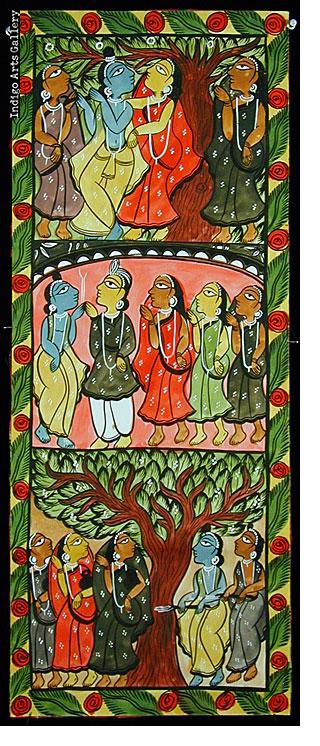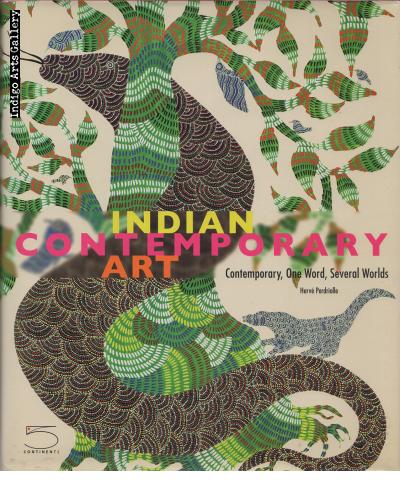The contemporary scrolls and paintings of Gurupada and Montu Chitrakar come from the distinct patachitra scroll tradition in the state of West Bengal. The patachitra or patua scrolls may portray stories from the great Hindu epics, such as the Ramayana, and Sufi traditions which are also sung frame by frame. The scrolls by the young painters Gurupada and Montu Chitrakar venture even further into current affairs, history and other subjects outside of the traditional canon.
Their subjects include not only the Ramayana but the Tsunami, the September 11th attacks, the Kashmir earthquake, the Gujarat earthquake and bloody Hindu/Muslim religious riots, and incongruously even the story of the French Revolution. For examples of some recent scrolls by various artists, depicting the December 2004 tsunami, go to our Art from the Tsunami gallery.
These scrolls are painted with vegetable dyes fixed with a vegetable gum on paper. The panels are sewn together and fabric from old saris is glued to the back to strengthen the scroll. Individual paintings by Montu Chitrakar may resemble single panels from these same scroll stories, or independent images of wild animals and scenes from his imagination.
Both Montu and Gurupada Chitrakar are featured in the exhibit Village of Painters: Narrative Scrolls from West Bengal at the Museum of International Folk Art in Santa Fe and the accompanying catalog by Frank Korom.
The Chitrakar scroll-painters are also featured in The Story Scrolls of Bengal, an article in the Winter 2015/2016 issue of Raw Vision magazine. An excerpt follows:
Author:
Shaheen Merali
Madhu and Hazra Chitrakar are artists based in the State of Bengal, East India. “Chitrakar” translates as “image maker”, and they are primarily self-taught – or, more precisely, taught within the lineage of family tradition, for their parents and grandparents would have also been Chitrakars and viewed as outsider artists. They are itinerant patua artists, whose pictoral stories are told with pigment on long scrolls. The stories traditionally revolve around common myths about gods, goddesses and epics that are re-told in different places, as they journey around the state. Either Hindu or Muslim, they occupy a marginalised status, forced to live on the outer fringes of their villages in rural Bengal. They are considered to be of the Hina by the upper-caste Hindus, which is a very lowly artists’ profession similar to the Muslim patnas. However, they are further reviled by orthodox Muslims for painting and singing in praise of Hindu gods, goddesses and mythology. Madhu, a Muslim with a Hindu name, is typical of this unusual social phenomenon.
The Chitrakars work in the traditional mode of wandering minstrels, a medieval tradition in which a singer from an artisanal family sings of events or myths with the accompaniment of a long, narrative scroll for the masses or performs in isolated villages. The full-sized scrolls are always accompanied by smaller works that portray singular figures from mythology, providing the opportunity to sell to the domestic, pedestrian market. The best-known drawings and paintings of nineteenth-century Bengal are the Kalighat Pats, created by village-based clay modellers and painters who settled in the vicinity of the famous Kali Temple of Kalighat in Kolkata. Increasingly, the Chitrakars’ work has been collected by their audience as well as other buyers and collectors who are beguiled by the singular humour, artistry and vibrancy.
On the reverse of the paper-painted patua scrolls, old and discarded pieces of cotton or silk saree fabric is attached. The hand-made texture of the paper, strengthened by the fabric backing and the use of vegetable pigments, allows the scrolls to be rolled up and transported [...].
Caption: Madhu and Hazra Chitrakar, 9/11 (detail), 2010, vegetable pigments on paper (with cloth backing), 44 x 300 ins. / 111.76 x 762 cm
Read the full article in:
Raw Vision #88 <http://rawvision.com/articles/story-scrolls-bengal>
Read more about the painters' village of Naya at:
Naya – a village where even a two-year-old knows how to hold a paintbrush
Painting the Pandemic: Coronavirus PatachitraScrolls in West Bengal, India



